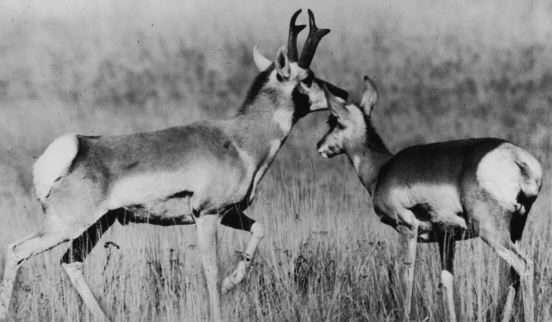
A single modern species is found in the family Antilocapridae, but the group has a fossil record going back to the Miocene. During its history, the Antilocapridae has included a diverse array of species (especially during the Pliocene and Pleistocene), some of which had multiple and bizarre horns.
The modern pronghorn is found in the deserts and dry grasslands of western North America. Pronghorns are of medium size, with a head and body between 1 and 1.5 m in length and a weight up to around 60 kg. Their body is stocky and they have long, thin legs. Their coat is pale brown dorsally and whitish ventrally, and they have distinctive black and white markings on their heads and necks. The pelage is dense and excellent insulation against both heat and cold. Their most distinctive feature is their horns, which are like those of bovids in that they consist of a keratinous sheath over a bony core, but differ because the keratinous sheath is shed periodically (annually in males, irregularly in females). These horns are erect and consist of two branches or prongs, a short branch extending forward and located around halfway up the horn, and a longer, backwardly directed tip.
The skulls of pronghorns are also distinctive. They lack a sagittal crest. A complete postorbital bar is present, and the orbits are large and placed far back on the skull, behind the level of the last molar. A vacuity (space) separates the nasal from the lacrimal on each side of the rostrum. The lacrimal canal is inside the orbit and has a single opening.
The postcranial skeleton of the antelope is that of a long-distance runner. The legs are long and paraxonic; the 3rd and 4th metapodials are fused to form cannon bones, the lateral digits are lost (the lateral metapodials may be present as vestiges), and the tarsals are reduced in number and generally cuboidal in shape. Pronghorn antelope are among the fastest long-distance runners, achieving bursts of speed of about 95 km/hr, and able to maintain speeds in excess of 50 km/hr for distances of several kilometers.
Pronghorn have hypsodont, selenodont cheek teeth. As in deer and bovids, the upper incisors are replaced by a horny pad, and the lower canine is incisor-like. The dental formula is 0/3, 0/1, 3/3, 3/3 = 32.
These artiodactyls are usually found in small herds or bands during the summer, but in larger aggregations of up to around 100 individuals in the winter. Their herds have a well-developed social hierarchy. The breeding system during the summer is polygyonous.
Pronghorns have excellent vision, and it has been suggested that the position of their eyes, high up on their skulls, is an adaptation that allows them to maintain vigilance for predators while they continue to crop vegetation on the ground.
 antilocarpa |
 pronghorn |
Family Suidae Family Tayassuidae Family Hippopotamidae Family Camelidae Family Tragulidae Family Giraffidae Family Moschidae Family Cervidae Family Antilocapridae Family Bovidae<<<<<<<>>>>>>> ARTIODACTYLA CARNIVORA CETACEA CHIROPTERA DASYUROMORPHIA DERMOPTERA DIDELPHIMORPHI DIPROTODONTIA HYRACOIDEA INSECTIVORA LAGOMORPHA MACROSCELIDEA MICROBIOTHERIA MONOTREMATA NOTORYCTEMORPHIA PAUCITUBERCULATA PERAMELEMORPHIA PERISSODACTYLA PHOLIDOTA PRIMATES PROBOSCIDEA RODENTIA SCANDENTIA SIRENIA TUBULIDENTATA XENARTHRA
Email: eradani7@aol.com